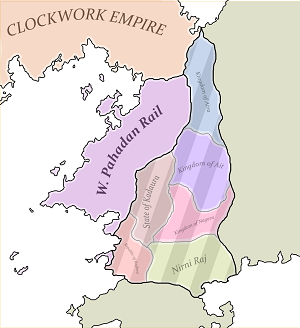West Pahadan Rail: Difference between revisions
No edit summary |
No edit summary |
||
| Line 39: | Line 39: | ||
|established_event7 = | |established_event7 = | ||
|established_date7 = | |established_date7 = | ||
|p1 = Various Pahadan Kingdoms | |||
|p2 = | |||
|p3 = | |||
|s1 = Imperial Federation | |||
|flag_s1 = Flag_Imperial_Federation_(Vapor).png | |||
|s2 = Republic of Western Pahadan | |||
|flag_s2 = | |||
|s3 = | |||
|flag_s3 = | |||
|area_rank = | |area_rank = | ||
|area_magnitude = | |area_magnitude = | ||
| Line 69: | Line 78: | ||
|Gini_year = | |Gini_year = | ||
|HDI = | |HDI = | ||
|currency = | |currency = leyi (¤; LY) | ||
|currency_code = | |currency_code = LY | ||
|time_zone = | |time_zone = IMT 0 | ||
|utc_offset = <!--in the form "+N", where N is number of hours offset--> | |utc_offset = <!--in the form "+N", where N is number of hours offset--> | ||
|time_zone_DST = <!--Link to DST (Daylight Saving Time) used, otherwise "not observed"--> | |time_zone_DST = <!--Link to DST (Daylight Saving Time) used, otherwise "not observed"--> | ||
| Line 77: | Line 86: | ||
|DST_note = <!--Optional note regarding DST use--> | |DST_note = <!--Optional note regarding DST use--> | ||
|antipodes = <!--Place/s exactly on the opposite side of the world to country/territory--> | |antipodes = <!--Place/s exactly on the opposite side of the world to country/territory--> | ||
|date_format = | |date_format = yyyy.dd.mm | ||
|drives_on = right <!--"right" or "left" (side of road)--> | |drives_on = right <!--"right" or "left" (side of road)--> | ||
|cctld = <!--Internet country code top-level domain identifier (e.g. [[.br]], [[.de]], etc) | |cctld = <!--Internet country code top-level domain identifier (e.g. [[.br]], [[.de]], etc) | ||
Revision as of 23:10, 17 May 2019
The West Pahadan Railway Company & The Automata Arms Corporation | |||||||||||
|---|---|---|---|---|---|---|---|---|---|---|---|
| c.1906 - 1951 | |||||||||||
|
Flag | |||||||||||
Motto: 'Crown, Company, Commerce' | |||||||||||
Anthem: Anthem of the Clockwork Empire | |||||||||||
 WPR (purple), its vassals (striped) and the Clockwork Empire (orange) | |||||||||||
| Capital and largest city | Nakashigawa | ||||||||||
| Official languages | Onghiri, Pahadan | ||||||||||
| Ethnic groups | Xian, Shihoki, Taebong, Zhuyeian, Sangam and Rukhanan | ||||||||||
| Demonym(s) | Korrukan | ||||||||||
| Government | Colonial Stratocratic Corporatocracy | ||||||||||
• CEO | Zhang Xieren | ||||||||||
• Chairman | Liang Yating | ||||||||||
| Legislature | Regional Unity Committee | ||||||||||
| Colonial Corporation | |||||||||||
| 1906 - 1910 | |||||||||||
| 1910 | |||||||||||
| 1912 | |||||||||||
| 1912 - 1921 | |||||||||||
| Population | |||||||||||
• 1918 estimate | 38,912,331 (within WPR) 84,074,512 (within its vassals) | ||||||||||
• 1920 census | 122,986,843 | ||||||||||
| Currency | leyi (¤; LY) (LY) | ||||||||||
| Time zone | IMT 0 | ||||||||||
| Date format | yyyy.dd.mm | ||||||||||
| Driving side | right | ||||||||||
| |||||||||||
The West Pahadan Rail Company, officially called The West Pahadan Railway Company and Automata Arms Corporation and often referred to by the initialism of WPR, was a colonial corporate and military holding of the Clockwork Empire in Western Pahada. Spanning from the steppes of Tungnir to the tropical forests of central Pahada, the colonial holding was regarded as 'the most powerful company in the world', as it played an integral role in every aspect of civilian life within it.
It was formed on the onset of Clockwork's Second Initiative in an attempt to better accommodate Korrukan investment in the region, predominantly railways and telecommunication lines. Early into its operation it became a conglomeration with 'Automata Arms', an Imperial arms manufacturer that had defaulted on its debts.
Whilst its original and primary function was the operation of the railways and telecommunications, WPR soon came to dominate every aspect of civilian, military and economic life within its territories once noted military officer and Grand Commandant Zhang Xieren became CEO in 1912. During this period it underwent aggressive industrialisation of the Pahadan coast, forced reallocation of ethnic groups, ethnic colonisation and would go on to conquer numerous Pahadan states that would become its vassals.
WPR was noted for its own highly trained security force, its permitted status to control Imperial armies in the region, its aggressive campaign for Korukkan nationalism with its influence back at home and its disregard for international treaties against the Empire, which culminated in the company producing and operating its own maritime fleet.
